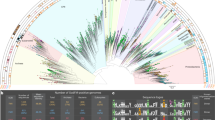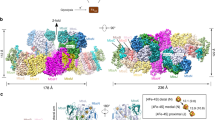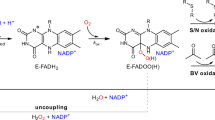Abstract
It is possible to travel back in time at the molecular level by reconstructing proteins from extinct organisms. Here we report the reconstruction, based on sequence predicted by phylogenetic analysis, of seven Precambrian thioredoxin enzymes (Trx) dating back between ~1.4 and ~4 billion years (Gyr). The reconstructed enzymes are up to 32 °C more stable than modern enzymes, and the oldest show markedly higher activity than extant ones at pH 5. We probed the mechanisms of reduction of these enzymes using single-molecule force spectroscopy. From the force dependency of the rate of reduction of an engineered substrate, we conclude that ancient Trxs use chemical mechanisms of reduction similar to those of modern enzymes. Although Trx enzymes have maintained their reductase chemistry unchanged, they have adapted over 4 Gyr to the changes in temperature and ocean acidity that characterize the evolution of the global environment from ancient to modern Earth.
This is a preview of subscription content, access via your institution
Access options
Subscribe to this journal
Receive 12 print issues and online access
$189.00 per year
only $15.75 per issue
Buy this article
- Purchase on Springer Link
- Instant access to full article PDF
Prices may be subject to local taxes which are calculated during checkout




Similar content being viewed by others
References
Benner, S.A., Sassi, S.O. & Gaucher, E.A. Molecular paleoscience: systems biology from the past. Adv. Enzymol. Relat. Areas Mol. Biol. 75, 1–132 (2007).
Thornton, J.W. Resurrecting ancient genes: experimental analysis of extinct molecules. Nat. Rev. Genet. 5, 366–375 (2004).
Liberles, D.A. (ed.) Ancestral Sequence Reconstruction (Oxford Univ. Press, Oxford, New York, 2007).
Hall, B.G. Simple and accurate estimation of ancestral protein sequences. Proc. Natl. Acad. Sci. USA 103, 5431–5436 (2006).
Thornton, J.W., Need, E. & Crews, D. Resurrecting the ancestral steroid receptor: ancient origin of estrogen signaling. Science 301, 1714–1717 (2003).
Thomson, J.M. et al. Resurrecting ancestral alcohol dehydrogenases from yeast. Nat. Genet. 37, 630–635 (2005).
Boussau, B., Blanquart, S., Necsulea, A., Lartillot, N. & Gouy, M. Parallel adaptations to high temperatures in the Archaean eon. Nature 456, 942–945 (2008).
Chang, B.S., Jonsson, K., Kazmi, M.A., Donoghue, M.J. & Sakmar, T.P. Recreating a functional ancestral archosaur visual pigment. Mol. Biol. Evol. 19, 1483–1489 (2002).
Gaucher, E.A., Thomson, J.M., Burgan, M.F. & Benner, S.A. Inferring the palaeoenvironment of ancient bacteria on the basis of resurrected proteins. Nature 425, 285–288 (2003).
Nisbet, E.G. & Sleep, N.H. The habitat and nature of early life. Nature 409, 1083–1091 (2001).
Pollock, D.D. & Chang, B.S.W. in Ancestral Sequence Reconstruction (ed. Liberles, D.A.) 85–94 (Oxford Univ. Press, Oxford, New York, 2007).
Gaucher, E.A., Govindarajan, S. & Ganesh, O.K. Palaeotemperature trend for Precambrian life inferred from resurrected proteins. Nature 451, 704–707 (2008).
Zalatan, J.G. & Herschlag, D. The far reaches of enzymology. Nat. Chem. Biol. 5, 516–520 (2009).
Holmgren, A. Thioredoxin. Annu. Rev. Biochem. 54, 237–271 (1985).
Wiita, A.P. et al. Probing the chemistry of thioredoxin catalysis with force. Nature 450, 124–127 (2007).
Perez-Jimenez, R. et al. Diversity of chemical mechanisms in thioredoxin catalysis revealed by single-molecule force spectroscopy. Nat. Struct. Mol. Biol. 16, 890–896 (2009).
Hedges, S.B. & Kumar, S. The Timetree of Life (Oxford Univ. Press, Oxford, 2009).
Yang, Z., Kumar, S. & Nei, M. A new method of inference of ancestral nucleotide and amino acid sequences. Genetics 141, 1641–1650 (1995).
Godoy-Ruiz, R. et al. Natural selection for kinetic stability is a likely origin of correlations between mutational effects on protein energetics and frequencies of amino acid occurrences in sequence alignments. J. Mol. Biol. 362, 966–978 (2006).
Kice, J.L. Nucleophilic substitution at different oxidation states of sulfur. in Progress in Inorganic Chemistry (ed. Edwards, J.O.) 147–206 (John Wiley & Sons, 2007).
Wiita, A.P., Ainavarapu, S.R., Huang, H.H. & Fernandez, J.M. Force-dependent chemical kinetics of disulfide bond reduction observed with single-molecule techniques. Proc. Natl. Acad. Sci. USA 103, 7222–7227 (2006).
Koti Ainavarapu, S.R., Wiita, A.P., Dougan, L., Uggerud, E. & Fernandez, J.M. Single-molecule force spectroscopy measurements of bond elongation during a bimolecular reaction. J. Am. Chem. Soc. 130, 6479–6487 (2008).
Garcia-Manyes, S., Liang, J., Szoszkiewicz, R., Kuo, T.L. & Fernandez, J.M. Force-activated reactivity switch in a bimolecular chemical reaction. Nat. Chem. 1, 236–242 (2009).
Liang, J. & Fernandez, J.M. Mechanochemistry: one bond at a time. ACS Nano 3, 1628–1645 (2009).
Holmgren, A. Reduction of disulfides by thioredoxin. Exceptional reactivity of insulin and suggested functions of thioredoxin in mechanism of hormone action. J. Biol. Chem. 254, 9113–9119 (1979).
Suarez, M. et al. Using multi-objective computational design to extend protein promiscuity. Biophys. Chem. 147, 13–19 (2010).
Holmgren, A. Thioredoxin catalyzes the reduction of insulin disulfides by dithiothreitol and dihydrolipoamide. J. Biol. Chem. 254, 9627–9632 (1979).
Walker, J.C.G. Possible limits on the composition of the archean ocean. Nature 302, 518–520 (1983).
Russell, M.J. & Hall, A.J. The emergence of life from iron monosulphide bubbles at a submarine hydrothermal redox and pH front. J. Geol. Soc. Lond. 154, 377–402 (1997).
Dyson, H.J. et al. Effects of buried charged groups on cysteine thiol ionization and reactivity in Escherichia coli thioredoxin: structural and functional characterization of mutants of Asp 26 and Lys 57. Biochemistry 36, 2622–2636 (1997).
Xu, S.Z. et al. TRPC channel activation by extracellular thioredoxin. Nature 451, 69–72 (2008).
Windle, H.J., Fox, A., Ni Eidhin, D. & Kelleher, D. The thioredoxin system of Helicobacter pylori. J. Biol. Chem. 275, 5081–5089 (2000).
Ming, H. et al. Crystal structure of thioredoxin domain of ST2123 from thermophilic archaea Sulfolobus tokodaii strain7. Proteins 69, 204–208 (2007).
Baker-Austin, C. & Dopson, M. Life in acid: pH homeostasis in acidophiles. Trends Microbiol. 15, 165–171 (2007).
Starks, C.M., Francois, J.A., MacArthur, K.M., Heard, B.Z. & Kappock, T.J. Atomic-resolution crystal structure of thioredoxin from the acidophilic bacterium Acetobacter aceti. Protein Sci. 16, 92–98 (2007).
Menzel, U. & Gottschalk, G. The internal pH of Acetobacterium wieringae and Acetobacter aceti during growth and production of acetic acid. Arch. Microbiol. 143, 47–51 (1985).
Knauth, L.P. & Lowe, D.R. High Archean climatic temperature inferred from oxygen isotope geochemistry of cherts in the 3.5 Ga Swaziland Supergroup, South Africa. Geol. Soc. Am. Bull. 115, 566–580 (2003).
Schulte, M. The emergence of life on earth. Oceanography (Wash. D.C.) 20, 42–49 (2007).
Gogarten-Boekels, M., Hilario, E. & Gogarten, J.P. The effects of heavy meteorite bombardment on the early evolution—the emergence of the three domains of life. Orig. Life Evol. Biosph. 25, 251–264 (1995).
Peregrin-Alvarez, J.M., Tsoka, S. & Ouzounis, C.A. The phylogenetic extent of metabolic enzymes and pathways. Genome Res. 13, 422–427 (2003).
Edgar, R.C. MUSCLE: multiple sequence alignment with high accuracy and high throughput. Nucleic Acids Res. 32, 1792–1797 (2004).
Yang, Z.H. PAML: a program package for phylogenetic analysis by maximum likelihood. Comput. Appl. Biosci. 13, 555–556 (1997).
Perez-Jimenez, R. et al. Force-clamp spectroscopy detects residue co-evolution in enzyme catalysis. J. Biol. Chem. 283, 27121–27129 (2008).
Ibarra-Molero, B., Loladze, V.V., Makhatadze, G.I. & Sanchez-Ruiz, J.M. Thermal versus guanidine-induced unfolding of ubiquitin. An analysis in terms of the contributions from charge-charge interactions to protein stability. Biochemistry 38, 8138–8149 (1999).
Fernandez, J.M. & Li, H. Force-clamp spectroscopy monitors the folding trajectory of a single protein. Science 303, 1674–1678 (2004).
Florin, E.L. et al. Sensing specific molecular interactions with the atomic-force microscope. Biosens. Bioelectron. 10, 895–901 (1995).
Nelder, J.A. & Mead, R.A. Simplex method for function minimization. Comput. J. 7, 308–313 (1965).
Acknowledgements
Supported by the US National Institutes of Health (HL061228 and HL066030 to J.M.F.); the Spanish Ministry of Science and Innovation (J.M.S.-R.); NASA Astrobiology (Georgia Institute of Technology); NASA Exobiology (E.A.G.); Fundación Ibercaja and Fundación Caja Madrid (R.P.-J. and S.G.-M.); and Fundación Alfonso Martín Escudero (J.A.-C.). We thank B. Ibarra-Molero (University of Granada) for assistance with bulk enzymatic assays.
Author information
Authors and Affiliations
Contributions
R.P.-J., J.M.S.-R., E.A.G. and J.M.F. designed the research; Z.-M.Z. and E.A.G. conducted the phylogenetic analysis and sequence reconstruction; A.I.-P. and J.M.S.-R. expressed and purified the ancestral enzymes and conducted the calorimetric measurements and analysis; T.J.K. provided A. aceti Trx; M.T. provided S. tokodaii Trx; A.H. provided human TRX; R.P.-J., I.S.-R., J.A.-C., P.K. and S.G.-M. performed AFM experiments; R.P.-J. and I.S.-R. analyzed AFM data; R.P.-J., E.A.G. and J.M.F. wrote the paper; all authors participated in revising the manuscript.
Corresponding authors
Ethics declarations
Competing interests
The authors declare no competing financial interests.
Supplementary information
Supplementary Text and Figures
Supplementary Figures 1–7, Supplementary Table 1 and Supplementary Note (PDF 1507 kb)
Rights and permissions
About this article
Cite this article
Perez-Jimenez, R., Inglés-Prieto, A., Zhao, ZM. et al. Single-molecule paleoenzymology probes the chemistry of resurrected enzymes. Nat Struct Mol Biol 18, 592–596 (2011). https://doi.org/10.1038/nsmb.2020
Received:
Accepted:
Published:
Issue Date:
DOI: https://doi.org/10.1038/nsmb.2020
This article is cited by
-
Reenacting the Birth of a Function: Functional Divergence of HIUases and Transthyretins as Inferred by Evolutionary and Biophysical Studies
Journal of Molecular Evolution (2021)
-
Ancestral Sequence Reconstruction: From Chemical Paleogenetics to Maximum Likelihood Algorithms and Beyond
Journal of Molecular Evolution (2021)
-
Evolution of frustrated and stabilising contacts in reconstructed ancient proteins
European Biophysics Journal (2021)
-
High performance crystalline nanocellulose using an ancestral endoglucanase
Communications Materials (2020)
-
Resurrection of efficient Precambrian endoglucanases for lignocellulosic biomass hydrolysis
Communications Chemistry (2019)



